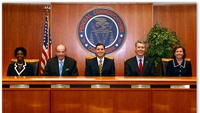In a blow to TV broadcasters, FCC approves unlicensed white space use for broadband

In a unanimous vote that cut across party lines, the FCC has approved the use of unlicensed broadcast airwaves known as white spaces for high-quality, long-range super Wi-Fi connections for portable communications devices.
It was the first significant block of spectrum opened for unlicensed use by the FCC in 20 years.
The unused channels between digital TV stations — ones that broadcasters had argued should not be used in order to protect their signals from interference — will now be used for mobile broadband services.
The vote was a major victory for companies like Google and Microsoft, who advocated the open use of the spectrum. It was also a loss for sports, theater and music venues that fear the use of the spectrum will interfere with their wireless microphone use.
“We haven't seen anything like this since the FCC 20 years ago approved the use of what was then thought to be unwanted spectrum and what today is used for Wi-Fi and other unlicensed consumer applications,“ said Harold Feld, the legal director for media reform group Public Knowledge. “Companies are eager to build devices and deploy the technologies. The FCC’s action is a clear signal to go ahead and get started constructing an exciting part of our future.”
The original order was approved two years ago under former FCC chairman Kevin Martin. That policy was challenged in court by broadcasters because of concerns of interference. The new order approved Thursday addresses some technical issues raised by those early opponents.
The FCC addressed 17 petitions for reconsideration of the November 2008 white spaces vote, agreeing to revamp parts of the original order.
Get the TV Tech Newsletter
The professional video industry's #1 source for news, trends and product and tech information. Sign up below.
The new order eliminates a requirement that devices must use real-time scanning of the broadcast airwaves for available signals. The commission ran spectrum-sensing tests using prototype devices during 2007 and 2008 with mixed results, with some spectrum-sensing devices failing to detect TV signals or wireless microphones.
Now, users of wireless devices can rely on a database of digital signals — updated daily — for use in locating an available channel on which to transmit. Commissioners called for the launch that database within a few months.
The NAB and MSTV, both of whom vehemently opposed the move to open up the white spaces, said their groups would review the details of the vote. “As with most highly technical decisions, the devil is in the details, and those details must be explored fully,” said David Donovan, president of MSTV.
“NAB’s overriding goal in this proceeding has been to ensure America’s continued interference-free access to high-quality news, entertainment and sports provided by free and local television stations,” said Dennis Wharton, NAB’s executive vice president of communications.
In an effort to protect wireless microphones from interference, commissioners voted to set aside two TV channels nationwide for wireless microphones. Those channels should allow 12 to 16 wireless microphones to operate in an area at the same time, said Hugh Van Tuyl, a senior staff engineer with the FCC’s Office of Engineering and Technology (OET).
If large sporting events or other users need additional spectrum for wireless microphones, they can ask to be temporarily included on an occupied-spectrum database designed to steer wireless devices away from those spectrum bands.
Wireless microphone maker Shure applauded the decision to set aside channels for microphones.
“It’s clear that the FCC carefully considered the needs of wireless microphone users while crafting this order,” said Sandy LaMantia, Shure’s president and CEO. “The reserved channels will provide a safe harbor in which musicians, small theaters, houses of worship and businesses can operate their wireless microphone systems without interference from new TV band devices.”
Elated supporters of the order hope the airwaves will be used for stronger and faster wireless networks — known as “super Wi-Fi” because of the signals’ ability to pass more easily through obstacles — and for use in providing Internet access to rural areas.
“Today’s order finally sets the stage for the next generation of wireless technologies to emerge and is an important victory for Internet users across the country,” said Richard Whitt, telecommunications and media counsel in Google’s Washington office.
The FCC also approved changes to the E-Rate program, which provides federal money to pay for Internet connections at schools and libraries. The new rules will allow them to set up Internet connections that use the currently dormant fiber-optic lines that are already in place in many communities, giving users more options and theoretically bringing down the cost of Internet service.
The new E-Rate rules also will allow schools to provide Internet access to their communities after students go home in the evenings, further expanding broadband availability.
Potential problems abound in the white spaces scenario, especially in urban areas, including New York City, where there are so many broadcast TV stations operating. Unused space is relatively rare in such areas.
However, Michael J. Copps, an FCC commissioner who has been a longtime advocate of freeing up the unlicensed airwaves, said that he expected technology companies would now find ways to overcome those obstacles.
“One of the great lessons that I quickly learned here at the FCC is the power of technology to turn scarcity into abundance,” Copps said. “I look forward to seeing new devices widely available in consumer markets next year.”
